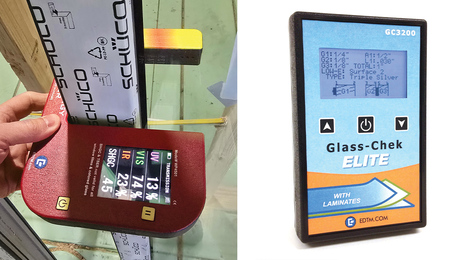I have one of those ink-pen sized electricity detectors that beeps when placed against a hot wire. Has saved me a couple of surprises. Last night I had a length of 14/3 wire running between two switches. The wire was NOT connected to anything. When I placed the detector against it (trying to do this routinely), it lit up, repeatedly. Both ends. All 4 wires would individually produce a signal. ?????? When I used a volt-meter on them, there was nothing. I went ahead and hooked up the switches, no shocks.
Any ideas why? The detector has always been reliable. It will only beep when the tip is within about 1/2 inch of a hot wire.




















Replies
A long wire, unconnected at either end, will pick up enough stray electricity in many cases to light a neon test meter, and likely to light one of those capacitive detectors.
Static electricity will do that to those types of testers...
Here fishy fishy....
If the dead wire comes close to or touches a hot somewhere, it'll signal hot.
Remodeling Contractor just outside the Glass City.
Quittin' Time
I had one that said my metal roof was hot..just got a Greenlee coupla days ago..more accurate..the other one was red (GB?) or somthin like that..new one has to ALMOST touch the wire..the otherone would pick up through a wall (mostly false alarms)..FWIW.
View Image
Spheramid Enterprises Architectural Woodworks
Repairs, Remodeling, Restorations.
I had one of those red GB detectors, too. POS.
Ron
I actually broke it taking it apart to install the hearing aid batteries..snapped the pocketclip in two..stupid design..funny with it..everything is hot...even a hunk o sheetrock on the floor.
View Image
Spheramid Enterprises Architectural Woodworks
Repairs, Remodeling, Restorations.
Ditto, took it back to Homer. Like the Fluke, do not have to push a button/clip.
You mean you don't see an aura around energized wires? Saves me a lot of money on instruments. Higher voltages have more of a blue color. Higher frequencies make the aura look fuzzier.
I can also tell by her aura when the old lady's in the mood for a round of slap and tickle. Saves a lot of missed approaches.
Mine is an Extech DVA30 combination voltage and current detector. The current detector is dead on, and it can detect flowing current through plaster walls, which is good in my K&T house. The voltage detector will sometimes give a false positive, but it will always do so when the probe is actually touched to the wire or fixture.
Better a false positive than a false negative.
I remember watching ZOOM on PBS as a kid in the 70s. They showed kids making stuff. Things that would never fly today - someone might get hurt. Anyway, on this one show, a kid made a primitive AM radio by climbing a HUGE pine tree and putting a single wire as an antenna up at the top. Then he came back down and connected it to a tin can with wires wrapped around it. I don't remember the details, but I do remember that the antenna generated enough electricity without any batteries, etc. by capturing radio waves that it turned a tin can into a primitive radio.
Maybe your disconnected wire was collecting radio waves and generating minute current that way. There's a rule in physics that I can't recall specifically that tells you how much current you generate as you pass a loop of wire through a magnetic field. If the wire is stationary, and the field (radio waves) are passing by it, it will generate some current. The longer the wire (or tin roof) the greater the current.
In the early days of radio, there were stations as strong as 500,000 watts. Story is that farmers nearby could light a chicken coop with the electricity they could pick up. (Being AM, it woulda flickered with the audio) But with the inverse square law, you'd have to be really close to a transmitter to get something that the sensor would read. The first one of those I had was from the Texas Association of Broadcasters. Not only could you use it for building power work, it would also let you know if you were dangerously close to RF.
-- J.S.
The original Marconi radio receivers actually had a spark gap "detector". The signal had to be strong enough to induce a spark. Of course, they had enormous antennas.
The original description of a batteryless crystal radio was in no way surprising. I had several of these as a kid. Even made a "foxhole" radio or two.
RE: "Better a false positive than a false negative".
Doesn't take a lot of induced current to trigger these devices. They read voltage not usable current. An unconnected cable running crossways to a single live one is often enough.
On the false negative side beware any situation where the voltage signal may be blocked. A steel conduit will do it. Pretty obvious I know but the neutral of a range cable wrapped around the other conductors, particularly if it is grounded, will also stop the signal. Four wire cables, where the neutral and ground are twisted can also block detection.
Found this out the hard way a few months after I got my first induction voltage detector. Was working where there were a half dozen range cables used. Checked one to make sure it was dead. Went to cut it with Kleins. Blew a hole just the right size to strip a #8. The explosion was quite impressive. Other electricians on the job described it as sounding like 'a cannon going off'. Once the flash blobs dimmed and the ringing stopped I got a good laugh out of it. After that I got into the habit of cutting down such cables and checking after I had free access to each conductor separately.
I like these tools. At least the good ones. But like any tool. They have limitations. Always pays to use a second means, one that operates on a different principle, to double check. Particularly where you can't get away or there are other safety concerns.
Fluke makes two different models. One low voltage and the standard higher voltage unit. I have both and the standard 120 vlt unit seems to be less sensitive to false positives than my Greenlee.
BTW, I applied for my masters license a few weeks ago. Still waiting to hear from them. Check cleared, but I don't know if that is really a good sign or not.
Dave
Congratulations on the Masters.
Not to worry. These sorts of things take time.
"Check cleared, but I don't know if that is really a good sign or not."
Better than bouncing <G>.
I suspect that even if you applied for one in the name of your dog that they would cash the check first. They worry about where they issue the isance or not.
Something that I learned from a refrigeration mechanic last year: Take your Greenlee(or other) tick tester into the frozen foods section at the grocery store and put it on the middle of the glass door of a freezer case.It'll chirp away if the anti-sweat heaters are on.These are the heaters in the metal frame surrounding the door glass that keeps the door from freezing shut w/condensation.You'd think glass is a pretty good electrical insulator but the tick will pick up the electrical field in the frame around it.
Edited 3/13/2004 5:21 pm ET by IBEW Barry
Caught just part of a Science Channel show the other night.
Seems one of the ISP experiments was to steam a long wire from the station or shuttle as theu orbit. The wire was several miles long and moving through the earths magnetic field induced a whale of a current. From the ground the wire looked lke a giant glowing filament. Lasted some time befor it went over current and burned into.
Would liked to have seen it, when it happened.
Dave